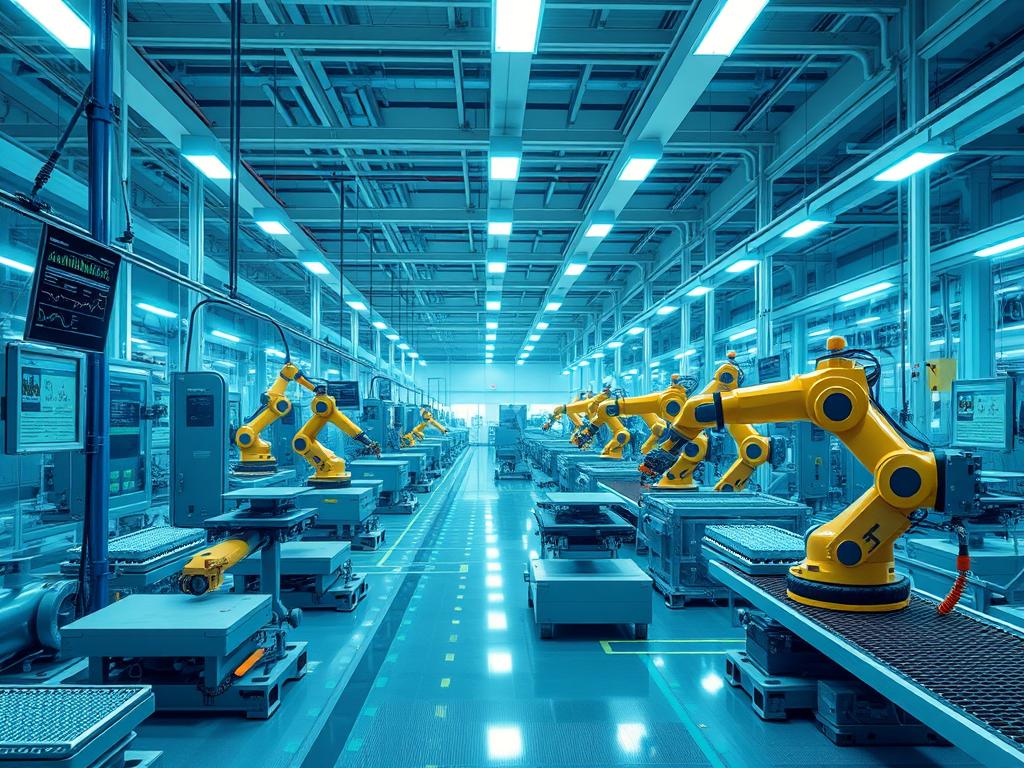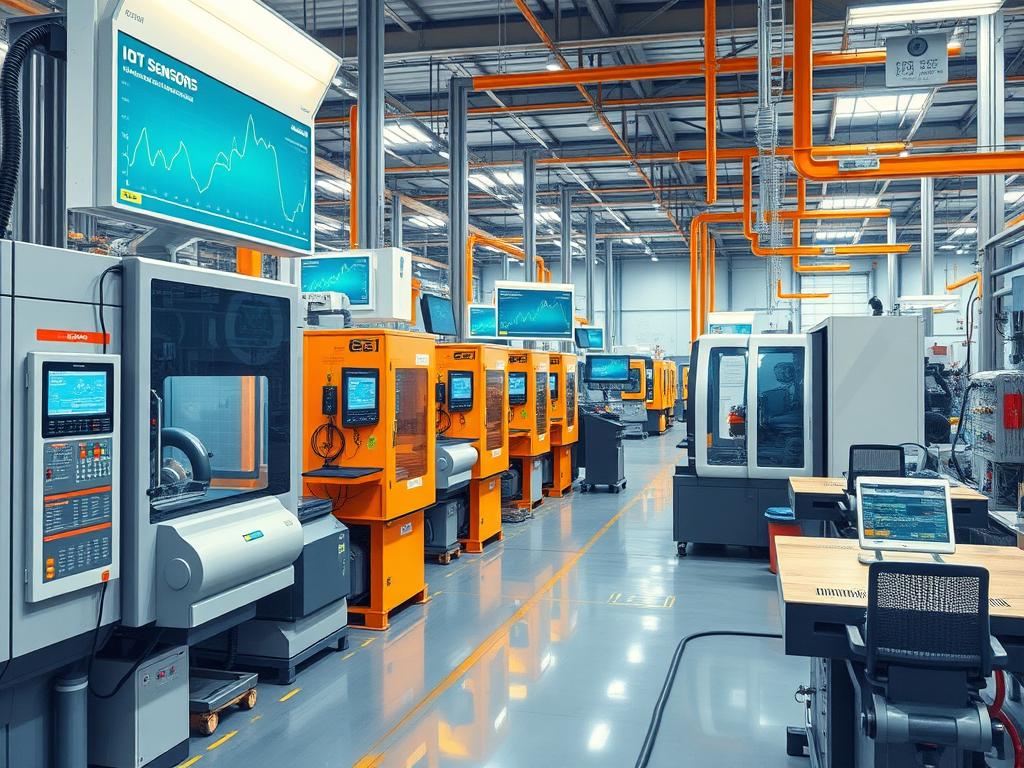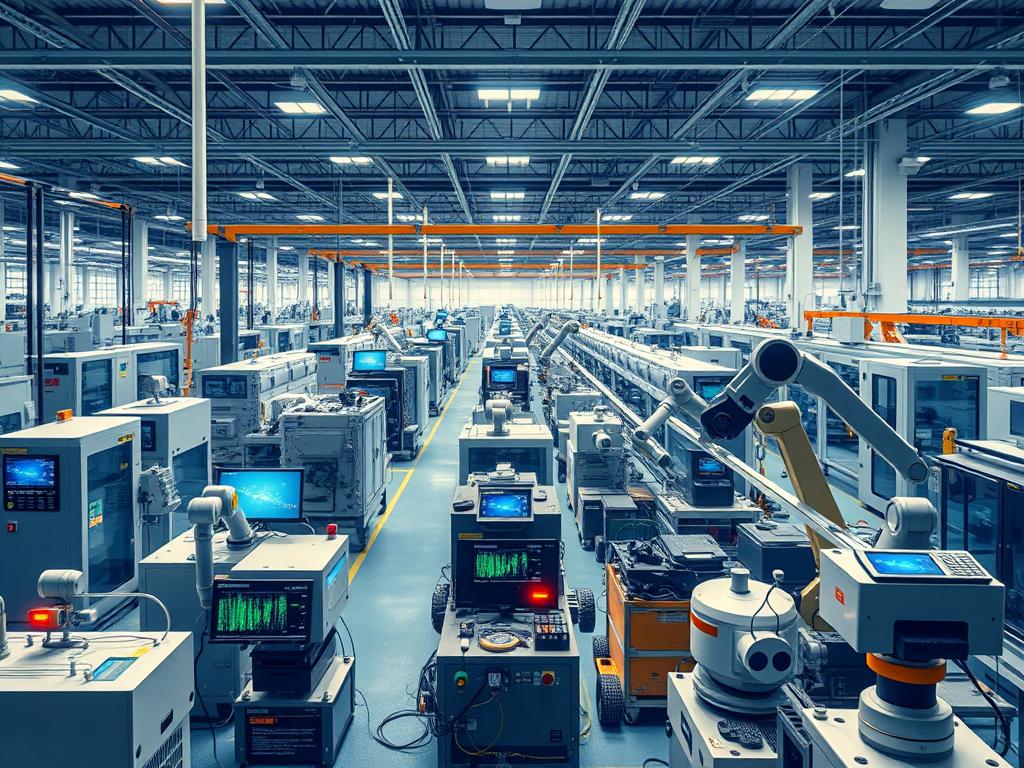By 2026, the IoT in manufacturing market could reach $87.9 billion. This growth shows the power of industrial IoT sensors in reshaping manufacturing. These smart sensors are changing production processes and boosting operational excellence.
IoT sensors in manufacturing represent a major shift in industrial operations. By 2024, 4.37 billion industrial devices may connect to IoT technology. Manufacturers use these sensors to boost efficiency and improve product quality.
This guide explores the benefits, uses, and future trends of IoT in manufacturing. It offers insights to help you stay ahead in this fast-changing industry.
Understanding IoT Sensors in the Manufacturing Sector
IoT sensors are transforming manufacturing operations. These smart devices turn factories into hubs of efficiency and innovation. They boost productivity and revolutionize traditional processes.
Definition and Key Features
IoT sensors in manufacturing collect and transmit data about production processes. They monitor factors like temperature, pressure, and vibration. This provides real-time insights into machine health and process efficiency.
Factory automation sensors drive this tech revolution. They enable smarter decisions and improve operational performance in manufacturing facilities.
Benefits of IoT Sensors
IoT sensor applications in manufacturing offer many advantages:
- Reduced downtime through predictive maintenance
- Enhanced quality control and product consistency
- Improved energy efficiency and cost savings
- Streamlined supply chain management
- Increased production speed and flexibility
Harley-Davidson cut motorcycle production time from three weeks to six hours using IoT sensors. Armal, a portable toilet maker, reduced energy costs by 40% with real-time IoT monitoring.
Common Types of IoT Sensors
Manufacturing facilities use various IoT sensors to optimize their operations:
| Sensor Type | Function | Application |
|---|---|---|
| Temperature Sensors | Monitor heat levels | Prevent overheating in machinery |
| Pressure Sensors | Measure force applied | Ensure optimal fluid levels |
| Vibration Sensors | Detect unusual movements | Predict equipment failures |
| Proximity Sensors | Detect nearby objects | Automate assembly lines |
These sensors form the backbone of smart manufacturing. They work with advanced data analytics to enable real-time monitoring. This allows quick responses to issues and data-driven decision-making.
Smart sensors position businesses for success in today’s competitive manufacturing landscape. They provide crucial insights that drive efficiency and innovation.
Real-world Applications of IoT Sensors in Manufacturing
IoT sensors are transforming manufacturing processes. They offer unmatched control and efficiency in factories. These smart devices are improving various aspects of production.
Predictive Maintenance
Predictive maintenance sensors are revolutionizing equipment upkeep. They monitor machine performance and detect issues before costly breakdowns occur. Companies now experience an average of just four hours of downtime in three years.
“Predictive maintenance has become a cornerstone of modern manufacturing, reducing maintenance costs by 10-40% and significantly minimizing unexpected downtime.”
Quality Control and Assurance
Process optimization sensors are crucial for maintaining product quality. They automate inspections, ensuring consistent quality and reducing human error. Up to 82% of companies face downtime due to quality issues.
IoT sensors for quality control are becoming increasingly important in manufacturing.

Asset Tracking
Asset monitoring sensors track equipment and inventory in real-time. This improves supply chain management and resource allocation. It also reduces losses from misplacement or theft.
The impact is significant. The IoT in manufacturing market could generate $87.9 billion in revenue in 2024.
| Application | Impact | Benefit |
|---|---|---|
| Predictive Maintenance | 10-40% cost reduction | Minimized downtime |
| Quality Control | Reduced defects | Improved product consistency |
| Asset Tracking | Enhanced visibility | Optimized resource utilization |
IoT sensors in manufacturing are growing rapidly. The industry expects a 14.2% annual growth rate through 2030. This points to a new era of efficiency and innovation.
Impact of IoT Sensors on Operational Efficiency
IoT sensors are transforming manufacturing by boosting operational efficiency. These smart devices provide real-time data for continuous production monitoring. This drives significant improvements across various operational aspects.
Reducing Production Downtime
Industrial IoT sensors minimize unplanned downtime, a major benefit. Unscheduled stoppages can cost manufacturers up to $260,000 per hour. This totals $50 billion annually across the industry.
IoT sensor data enables predictive maintenance strategies. Companies can extend equipment lifespan and reduce costly interruptions. This proactive approach saves money and improves productivity.
Enhancing Decision-Making
IoT sensors provide data-driven insights for better decision-making. Companies can analyze machine performance data to identify trends and patterns. This guides maintenance or replacement decisions.
A proactive approach ensures optimal equipment performance. It also reduces the risk of unexpected failures. Smart sensors help maintain smooth operations.
Streamlining Supply Chain Management
Supply chain sensors optimize logistics and inventory management. These devices offer real-time visibility into transportation and inventory levels. This helps manufacturers reduce lead times and improve overall efficiency.
Smart sensors and RFID tags enhance tracking throughout the manufacturing process. They ensure better resource allocation and minimize bottlenecks. This leads to a more efficient supply chain.

| IoT Impact Area | Benefits | Projected Value |
|---|---|---|
| Predictive Maintenance | Reduced downtime, extended equipment life | $50 billion annual savings |
| Supply Chain Management | Improved visibility, optimized logistics | Reduced lead times |
| Overall IoT in Manufacturing | Enhanced efficiency, quality, and decision-making | $194.9 billion market by 2030 |
IoT adoption in manufacturing is growing rapidly. By 2012, 12% of North American firms had implemented IoT solutions. The global economic impact of IoT could reach $11.1 trillion by 2025.
Challenges of Implementing IoT Sensors
Industrial IoT sensors offer huge benefits to manufacturing. However, they come with hurdles. Factories need careful planning to tackle these challenges as they adopt smart tech.
Integration with Existing Systems
Merging IoT sensors with old systems is a big challenge. Many factories use equipment not built for connectivity. This causes issues with data flow between old and new setups.
To succeed, factories need a unified approach. This helps link data from various sources. It ensures a clear view of all operations.
Data Security Concerns
Factory sensors create vast amounts of data. This makes security crucial. The connected nature of IoT in manufacturing increases cyber risks.
Protecting sensitive info is a top concern. Preventing unauthorized access is vital. Robust security measures and constant vigilance are necessary.
Cost Implications
IoT sensors require big upfront investments. Costs include sensors, infrastructure, integration, and training. Microsoft’s 2019 IoT Signals report shows a key fact.
29% of organizations delay IoT adoption due to lack of resources. This highlights the financial hurdle many face.

| Challenge | Impact | Potential Solution |
|---|---|---|
| System Integration | Interoperability issues, data silos | Phased implementation, middleware solutions |
| Data Security | Increased cyber risk, data breaches | Robust encryption, regular security audits |
| Cost | High initial investment, ROI concerns | Scalable implementation, focus on high-impact areas |
The benefits of IoT in manufacturing are huge. McKinsey predicts IoT could be worth $470 billion yearly by 2025. Tackling challenges head-on can unlock IoT’s full potential.
Strategic planning helps manufacturers reap rewards. They can boost efficiency, quality, and innovation with industrial IoT sensors.
Selecting the Right IoT Sensors for Your Manufacturing Needs
Choosing IoT sensors for manufacturing is vital for optimizing processes and boosting efficiency. Manufacturers must consider their specific needs when selecting from 14 essential types of IoT sensors.
Factors to Consider
Several key factors influence the selection of iot sensors for manufacturing. These include form factor, size, power consumption, and data transmission volume.
Security considerations and compatibility with existing systems are also crucial. These factors impact sensor data analytics and overall process optimization.
Companies should prioritize sensors that align with their specific requirements. This approach ensures improved efficiency through detailed operational data.
Leading Brands and Solutions
Top companies provide IoT solutions across various industries. Here are some examples:
| Brand | Specialization | Key Features |
|---|---|---|
| Bosch | Industrial IoT | High precision, robust design |
| Honeywell | Smart building solutions | Energy efficiency, integrated systems |
| Siemens | Manufacturing automation | Advanced analytics, scalability |
Future Trends to Watch
The future of process optimization sensors looks bright. Advancements will enable more connected devices and longer-distance data collection in manufacturing.
Smart sensor networks can detect machinery condition changes before major failures occur. This could save up to 20% in productivity and reduce defects by 80%.
Sensors play a growing role in IoT technology innovation. Manufacturers can expect improved quality control and faster response times.
More efficient predictive maintenance strategies are on the horizon. This evolution in sensor technology will revolutionize manufacturing processes.
Significant cost savings and operational improvements are expected. The future of manufacturing looks promising with these advancements in sensor technology.
Future of IoT Sensors in Manufacturing
Smart manufacturing sensors are transforming the industry. The IoT manufacturing market is set to reach $200.3 billion by 2030. This growth shows industrial IoT sensors are becoming crucial.
Innovations on the Horizon
Edge computing with IIoT tech is an exciting development. It allows faster data processing from IoT sensor applications near the source. This is vital as manufacturing used 33% of U.S. energy in 2020.
Industry-Specific Case Studies
Industrial IoT sensors are already showing great results. They help reduce equipment downtime, which costs $50 billion yearly. Gartner predicts 20% of industrial equipment makers will use remote IoT by 2023.
The Role of AI and Machine Learning
AI and machine learning with smart sensors will change manufacturing. These techs can boost productivity and improve decision-making. Battery monitoring systems with AI can enhance safety and efficiency.
By 2025, over 75 billion IoT devices will be connected. This opens up endless possibilities for AI-driven insights in manufacturing.


